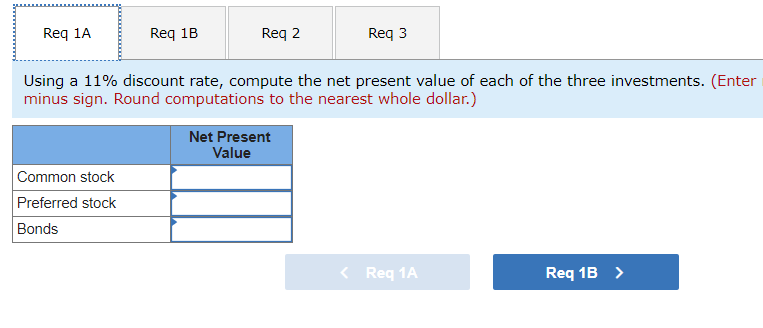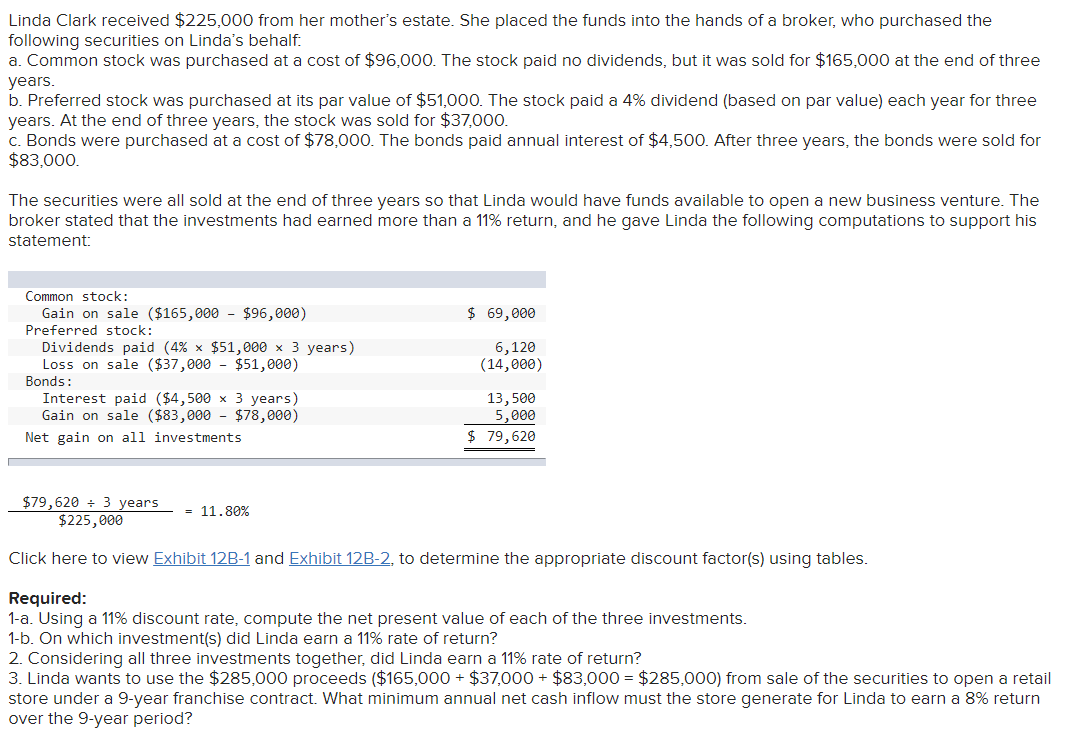Linda Clark received $225,000 from her mother's estate. She placed the funds into the hands of a broker, who purchased the following securities on Linda's behalf: a. Common stock was purchased at a cost of $96,000. The stock paid no dividends, but it was sold for $165,000 at the end of three years. b. Preferred stock was purchased at its par value of $51,000. The stock paid a 4% dividend (based on par value) each year for three years. At the end of three years, the stock was sold for $37,000. c. Bonds were purchased at a cost of $78,000. The bonds paid annual interest of $4,500. After three years, the bonds were sold for $83,000. The securities were all sold at the end of three years so that Linda would have funds available to open a new business venture. The broker stated that the investments had earned more than a 11% return, and he gave Linda the following computations to support his statement: Common stock: Gain on sale ($165,000 - $96,000) $ 69,000 Preferred stock: Dividends paid (4% x $51,000 x 3 years) Loss on sale ($37,000 - $51,000) Bonds: 6,120 (14,000) Interest paid ($4,500 x 3 years) Gain on sale ($83,000 - $78,000) 13,500 5,000 $ 79,620 Net gain on all investments $79,620 + 3 years $225,000 = 11.80% Click here to view Exhibit 12B-1 and Exhibit 12B-2, to determine the appropriate discount factor(s) using tables. Required: 1-a. Using a 11% discount rate, compute the net present value of each of the three investments. 1-b. On which investment(s) did Linda earn a 11% rate of return? 2. Considering all three investments together, did Linda earn a 11% rate of return? 3. Linda wants to use the $285,000 proceeds ($165,000 + $37,000 + $83,000 = $285,000) from sale of the securities to open a retail store under a 9-year franchise contract. What minimum annual net cash inflow must the store generate for Linda to earn a 8% return over the 9-year period?
Linda Clark received $225,000 from her mother's estate. She placed the funds into the hands of a broker, who purchased the following securities on Linda's behalf: a. Common stock was purchased at a cost of $96,000. The stock paid no dividends, but it was sold for $165,000 at the end of three years. b. Preferred stock was purchased at its par value of $51,000. The stock paid a 4% dividend (based on par value) each year for three years. At the end of three years, the stock was sold for $37,000. c. Bonds were purchased at a cost of $78,000. The bonds paid annual interest of $4,500. After three years, the bonds were sold for $83,000. The securities were all sold at the end of three years so that Linda would have funds available to open a new business venture. The broker stated that the investments had earned more than a 11% return, and he gave Linda the following computations to support his statement: Common stock: Gain on sale ($165,000 - $96,000) $ 69,000 Preferred stock: Dividends paid (4% x $51,000 x 3 years) Loss on sale ($37,000 - $51,000) Bonds: 6,120 (14,000) Interest paid ($4,500 x 3 years) Gain on sale ($83,000 - $78,000) 13,500 5,000 $ 79,620 Net gain on all investments $79,620 + 3 years $225,000 = 11.80% Click here to view Exhibit 12B-1 and Exhibit 12B-2, to determine the appropriate discount factor(s) using tables. Required: 1-a. Using a 11% discount rate, compute the net present value of each of the three investments. 1-b. On which investment(s) did Linda earn a 11% rate of return? 2. Considering all three investments together, did Linda earn a 11% rate of return? 3. Linda wants to use the $285,000 proceeds ($165,000 + $37,000 + $83,000 = $285,000) from sale of the securities to open a retail store under a 9-year franchise contract. What minimum annual net cash inflow must the store generate for Linda to earn a 8% return over the 9-year period?
SWFT Essntl Tax Individ/Bus Entities 2020
23rd Edition
ISBN:9780357391266
Author:Nellen
Publisher:Nellen
Chapter18: Comparative Forms Of Doing Business
Section: Chapter Questions
Problem 19P
Related questions
Question

Transcribed Image Text:Req 1A
Req 1B
Req 2
Req 3
Using a 11% discount rate, compute the net present value of each of the three investments. (Enter
minus sign. Round computations to the nearest whole dollar.)
Net Present
Value
Common stock
Preferred stock
Bonds
< Req 1A
Req 1B >

Transcribed Image Text:Linda Clark received $225,000 from her mother's estate. She placed the funds into the hands of a broker, who purchased the
following securities on Linda's behalf:
a. Common stock was purchased at a cost of $96,000. The stock paid no dividends, but it was sold for $165,000 at the end of three
years.
b. Preferred stock was purchased at its par value of $51,000. The stock paid a 4% dividend (based on par value) each year for three
years. At the end of three years, the stock was sold for $37,000.
c. Bonds were purchased at a cost of $78,000. The bonds paid annual interest of $4,500. After three years, the bonds were sold for
$83,000.
The securities were all sold at the end of three years so that Linda would have funds available to open a new business venture. The
broker stated that the investments had earned more than a 11% return, and he gave Linda the following computations to support his
statement:
Common stock:
Gain on sale ($165,000 - $96,000)
$ 69,000
Preferred stock:
Dividends paid (4% x $51,000 x 3 years)
Loss on sale ($37,000 - $51,000)
Bonds:
6,120
(14,000)
Interest paid ($4,500 x 3 years)
Gain on sale ($83,000 - $78,000)
13,500
5,000
$ 79,620
Net gain on all investments
$79,620 + 3 years
$225,000
= 11.80%
Click here to view Exhibit 12B-1 and Exhibit 12B-2, to determine the appropriate discount factor(s) using tables.
Required:
1-a. Using a 11% discount rate, compute the net present value of each of the three investments.
1-b. On which investment(s) did Linda earn a 11% rate of return?
2. Considering all three investments together, did Linda earn a 11% rate of return?
3. Linda wants to use the $285,000 proceeds ($165,000 + $37,000 + $83,000 = $285,000) from sale of the securities to open a retail
store under a 9-year franchise contract. What minimum annual net cash inflow must the store generate for Linda to earn a 8% return
over the 9-year period?
Expert Solution
This question has been solved!
Explore an expertly crafted, step-by-step solution for a thorough understanding of key concepts.
This is a popular solution!
Trending now
This is a popular solution!
Step by step
Solved in 3 steps with 3 images

Knowledge Booster
Learn more about
Need a deep-dive on the concept behind this application? Look no further. Learn more about this topic, accounting and related others by exploring similar questions and additional content below.Recommended textbooks for you







Individual Income Taxes
Accounting
ISBN:
9780357109731
Author:
Hoffman
Publisher:
CENGAGE LEARNING - CONSIGNMENT

